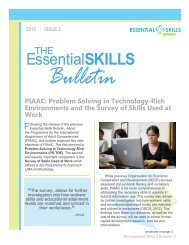Uncharted Territory - Essential Skills Ontario
Uncharted Territory - Essential Skills Ontario
Uncharted Territory - Essential Skills Ontario
Create successful ePaper yourself
Turn your PDF publications into a flip-book with our unique Google optimized e-Paper software.
WHERE DOES SOCIAL INNOVATION HAPPEN?3.3 The Private SectorBusiness is increasingly coming to view engagement in social issues as asource of new ideas, reputation and recruitment. Many private entrepreneurssee social innovation as a way to create new business opportunities, growbrand loyalty through association with well-known charities or socialenterprises, or attract employees who want a socially conscious employer anda stimulating culture of innovation. The continued growth of social industries– such as health, education, training and long-term care – can createopportunities for collaboration and a new alignment of expertise.One of the most significant developments over the past twenty years hasbeen the growth in the number of social enterprises and entrepreneursrunning businesses that earn a profit but also focus on social goals. The mainchallenge for social enterprises is to maintain their commercial position in themarket while staying true to their social goals - not an easy task. Some smallenterprises lack the resources to take their innovations to larger markets. Iflarger commercial organizations see value in these innovations, they oftenseize the opportunities, pushing smaller enterprises to the sidelines. This hasoccurred in organics, fair trade and recycling. Alternatively, clusters of socialenterprises have developed a network for collaboration and joint serviceswhich have enabled them to access services normally available only to largefirms while remaining small themselves (Murray et al., 2010).3.4 The Three Sectors Working Together for Collective ImpactAn example of social innovation in which third sector, business andgovernment work closely together to achieve large-scale change comes in thedevelopment of technology for business, academic research and skillsdevelopment. Many universities and colleges have paired up or aligned theiractivities with technology companies. The lines between classroom researchand industry technology development are becoming increasingly blurred.While not everyone agrees with this growing trend and relevant questions arebeing raised about the extent to which the traditional mission of educationalinstitutions may be compromised, this “blurring” is seen in some quarters as acritically important lever for facilitating economic growth and a regionaladvantage in attracting industry (<strong>Essential</strong> <strong>Skills</strong> <strong>Ontario</strong>, 2012). While thisapproach has been a longstanding tradition in medical research, and wherecriticism has been most pronounced, countries such as Finland, theNetherlands and Japan have adopted it to advanced technology developmentbetween universities and private research and development divisions inindustry. In the United States, many universities and colleges are pairing upwith regional economic development offices to kick-start local economiesthrough knowledge transfer hubs that often center on the creation,diversification, and industrial application of emerging technology.[see Universities and regional economic development p.13]12 • <strong>Uncharted</strong> <strong>Territory</strong>: Can Social Innovation Revitalize Literacy and <strong>Essential</strong> <strong>Skills</strong> Programs?




